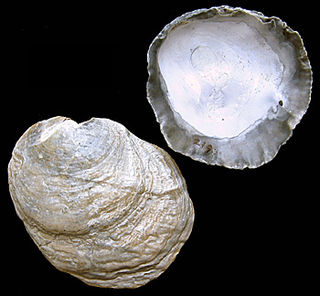
Atrina fragilis, the fan mussel, is a species of large saltwater clam, a marine bivalve mollusc in the family Pinnidae, the pen shells.
The pod razor is a coastal bivalve of European waters. It is edible and has been fished commercially, especially in Portugal, Spain, Ireland and Scotland.

A bivalve shell is part of the body, the exoskeleton or shell, of a bivalve mollusk. In life, the shell of this class of mollusks is composed of two hinged parts or valves. Bivalves are very common in essentially all aquatic locales, including saltwater, brackish water, and freshwater. The shells of bivalves commonly wash up on beaches and along the edges of lakes, rivers, and streams. Bivalves by definition possess two shells or valves, a "right valve" and a "left valve", that are joined by a ligament. The two valves usually articulate with one another using structures known as "teeth" which are situated along the hinge line. In many bivalve shells, the two valves are symmetrical along the hinge line—when truly symmetrical, such an animal is said to be equivalved; if the valves vary from each other in size or shape, inequivalved. If symmetrical front-to-back, the valves are said to be equilateral, and are otherwise considered inequilateral.

Mya truncata, common name the blunt gaper or truncate softshell, is a species of edible saltwater clam, a marine bivalve mollusk in the family Myidae.

Pododesmus patelliformis, the ribbed saddle-oyster, is a species of bivalve mollusc in the family Anomiidae. It is found in the north east Atlantic Ocean.

Ensis ensis, or the sword razor, is a razor clam, a marine bivalve mollusc in the family Pharidae. It lives buried in the sand and is found off the coasts of northwest Europe.

Fabulina fabula, the bean-like tellin, is a species of marine bivalve mollusc in the family Tellinidae. It is found off the coasts of northwest Europe, where it lives buried in sandy sediments.

Tellina tenuis, the thin tellin, is a species of marine bivalve mollusc in the family Tellinidae. It is found off the coasts of northwest Europe and in the Mediterranean Sea, where it lives buried in sandy sediments.

Tellimya ferruginosa is a species of small marine bivalve mollusc in the family Lasaeidae. It is found on the eastern side of the Atlantic Ocean.

Abra alba, or the white furrow shell, is a species of bivalve mollusc in the family Semelidae. It occurs in the northeastern Atlantic Ocean and the Mediterranean Sea, where it lives on the floor in shallow areas buried in soft sediments.
Phaxas is a genus of small razor shells in the family Pharidae. Members of the genus have a pair of elongate valves and live in soft sediments on the sea bed. They have a muscular foot with which they can dig rapidly and a short siphon which they extend to the surface of the substrate. They are suspension feeders.

Lagis koreni, commonly known as the trumpet worm, is a species of marine polychaete worm found in European waters. It lives within a narrow conical tube made of grains of sand and shell fragments.

Lutraria is a genus of medium-sized marine bivalve mollusks or clams, commonly known as otter shells.

Lutraria lutraria is a species of large marine bivalve mollusc in the family Mactridae. Its common names include the otter shell and the common otter shell. It occurs in coastal regions of the north east Atlantic Ocean where it lives buried in the sand.

Venerupis decussata is a marine bivalve mollusc in the family Veneridae, commonly known as the cross-cut carpet shell.

Thracia convexa is a bivalve mollusc in the family Thraciidae.

Donax vittatus, or the banded wedge shell, is a species of bivalve mollusc in the order Cardiida. It is found on beaches in northwest Europe buried in the sand on the lower shore.

Mulinia lateralis, the dwarf surf clam or coot clam, is a species of small saltwater clam, a bivalve mollusc in the family Mactridae. It occurs in the western Atlantic Ocean and the Caribbean Sea.

Solecurtus strigilatus, also known as the rosy razor clam, is a species of saltwater clam, a marine bivalve mollusc in the family Solecurtidae. This mollusc is a suspension feeder and can burrow with great rapidity to escape predators. It is an unusual bivalve in that its shell valves are too small to contain all the soft tissue, and the animal is unable to retreat into its shell.

Pharus legumen, is a species of bivalve mollusc commonly found burrowed in the sand on lower shores and in the shallow sublittoral.
















